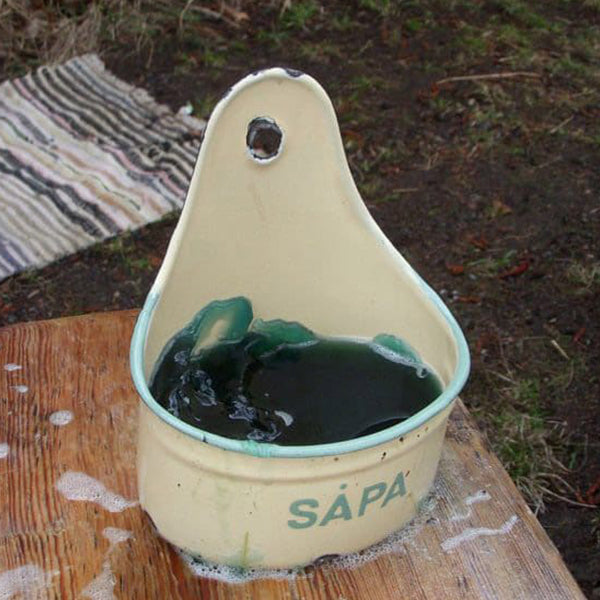Green or yellow soap, yellow soap or green soap – what is the difference?




Soaps in different colors are confusing, but here we will clarify what is what!
Soap can be made from virtually any fat. The principle is that fat is saponified with potassium hydroxide and then the soap is boiled until it is ready. The glycerol that is released is not removed, unlike what is done in the manufacture of soap, which contributes to giving the soap a smooth consistency.
In the past, it was common to saponify animal fat!
It produced a very useful soap. In addition, all surplus was utilized, nothing was wasted. A sustainable method for self-sufficiency. The soap became a little milky; animal fats never give completely transparent soap.
Yellow soap has also long been made from tall oil; tall oil is a by-product from the paper pulp industry. The brown mass that smells of "paper mill" is purified and saponified. It gives a yellow, effective, and slightly "harsh" soap. This soap is excellent for regular cleaning in, for example, the bathroom. It is also a recycling that provides an environmentally friendly cleaning agent. What you should keep in mind is not to choose tall oil soap to re-grease wood, as it does not have the caring properties that, for example, a linseed oil soap has. This is because it lacks excess fat. For those who are allergic to pine, you should also remember to wear gloves as residues of resin / rosin may remain in the product.
Linseed oil soap is a yellow soap, usually a little more expensive, but very good for all wood products. Linseed oil soap cares for and re-greases wood in a very good way. Produced by saponification of linseed oil.
Should you then use green or yellow soap for decking?
The answer is that you should use a superfatted soap, as much fat as possible is the thing to get a nice patio or wooden decking. What you are looking for is a natural graying and a velvety surface that does not attract pollen, dust, grass, and leaves. Beautiful and easy to clean. The decking becomes like an old-fashioned scrubbed floor from being soaped.
As you can also read all about here on the right, it is very difficult to get hold of real green soap today. The risk is great that it is a colored soap you have in your hand. Read the label, if it says saponified hemp oil, it is real green soap... if not, then it is something else.
Here you will find our decking soap
Green soap was made from oil from hemp (hemp seeds – by-product from rope manufacturing), which gives green soap.
When hemp cultivation was banned in Sweden in 1970–2005, a natural consequence was that green soap disappeared. There was simply no oil to saponify. Since the market still existed for green soap, yellow soap has since been colored green. It has the green color but lacks the caring properties that real green soap had. So, if you buy green soap today, the chances are good that you are buying colored tall oil soap, so you might as well choose the yellow tall oil soap so you avoid the dye. Colored green soap is also perfumed in a different way than the yellow soap to create the illusion of real green soap. Today, it is legal for farmers to grow certain varieties of so-called industrial hemp with a THC content lower than 0.2 percent, I cannot find any information today that there is anyone who manufactures real green soap in Sweden, but perhaps the real green soap will return one day.

Photo: Wikipedia
Västerbottenssåpa is yellow. Västerbottenssåpa is made from corn/rapeseed oil – cooking oil that is purified and saponified. Rapeseed and corn are very similar to linseed oil, so Västerbottenssåpa has the caring properties that a linseed oil soap also has. So, there is an excess of fat, which makes it easy to dissolve greasy dirt with greasy soap, and so it re-greases and cares for wooden floors, furniture, and all other wood.
